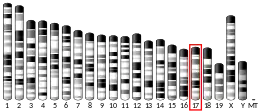PACRG
Parkin coregulated gene protein is a protein that in humans is encoded by the PACRG gene.[5][6]
| PACRG | |||||||||||||||||||||||||||||||||||||||||||||||||||
|---|---|---|---|---|---|---|---|---|---|---|---|---|---|---|---|---|---|---|---|---|---|---|---|---|---|---|---|---|---|---|---|---|---|---|---|---|---|---|---|---|---|---|---|---|---|---|---|---|---|---|---|
| Identifiers | |||||||||||||||||||||||||||||||||||||||||||||||||||
| Aliases | PACRG, GLUP, HAK005771, PARK2CRG, PARK2 co-regulated, PARK2 coregulated, parkin coregulated, PACRG2.1 | ||||||||||||||||||||||||||||||||||||||||||||||||||
| External IDs | OMIM: 608427 MGI: 1916560 HomoloGene: 16212 GeneCards: PACRG | ||||||||||||||||||||||||||||||||||||||||||||||||||
| |||||||||||||||||||||||||||||||||||||||||||||||||||
| |||||||||||||||||||||||||||||||||||||||||||||||||||
| |||||||||||||||||||||||||||||||||||||||||||||||||||
| |||||||||||||||||||||||||||||||||||||||||||||||||||
| |||||||||||||||||||||||||||||||||||||||||||||||||||
| Wikidata | |||||||||||||||||||||||||||||||||||||||||||||||||||
| |||||||||||||||||||||||||||||||||||||||||||||||||||
This gene encodes a protein that is conserved across metazoans. In vertebrates, this gene is linked in a head-to-head arrangement with the adjacent parkin gene, which is associated with autosomal recessive juvenile Parkinson's disease. These genes are co-regulated in various tissues and they share a bi-directional promoter. Both genes are associated with susceptibility to leprosy. The parkin co-regulated gene protein forms a large molecular complex with chaperones, including heat shock proteins 70 and 90, and chaperonin components. This protein is also a component of Lewy bodies in Parkinson's disease patients, and it suppresses unfolded Pael receptor-induced neuronal cell death. Multiple transcript variants encoding different isoforms have been found for this gene.[6]
References
- GRCh38: Ensembl release 89: ENSG00000112530 - Ensembl, May 2017
- GRCm38: Ensembl release 89: ENSMUSG00000037196 - Ensembl, May 2017
- "Human PubMed Reference:". National Center for Biotechnology Information, U.S. National Library of Medicine.
- "Mouse PubMed Reference:". National Center for Biotechnology Information, U.S. National Library of Medicine.
- West AB, Lockhart PJ, O'Farell C, Farrer MJ (Jan 2003). "Identification of a novel gene linked to parkin via a bi-directional promoter". Journal of Molecular Biology. 326 (1): 11–9. doi:10.1016/S0022-2836(02)01376-1. PMID 12547187.
- "Entrez Gene: PACRG PARK2 co-regulated".
Further reading
- Schurr E, Alcaïs A, de Léséleuc L, Abel L (2006). "Genetic predisposition to leprosy: A major gene reveals novel pathways of immunity to Mycobacterium leprae". Seminars in Immunology. 18 (6): 404–10. doi:10.1016/j.smim.2006.07.005. PMID 16973374.
- Venter JC, Adams MD, Myers EW, et al. (2001). "The sequence of the human genome". Science. 291 (5507): 1304–51. Bibcode:2001Sci...291.1304V. doi:10.1126/science.1058040. PMID 11181995.
- Strausberg RL, Feingold EA, Grouse LH, et al. (2003). "Generation and initial analysis of more than 15,000 full-length human and mouse cDNA sequences". Proceedings of the National Academy of Sciences. 99 (26): 16899–903. Bibcode:2002PNAS...9916899M. doi:10.1073/pnas.242603899. PMC 139241. PMID 12477932.
- Mira MT, Alcaïs A, Van Thuc N, et al. (2003). "Chromosome 6q25 is linked to susceptibility to leprosy in a Vietnamese population". Nature Genetics. 33 (3): 412–5. doi:10.1038/ng1096. PMID 12577057. S2CID 35810055.
- Imai Y, Soda M, Murakami T, et al. (2004). "A product of the human gene adjacent to parkin is a component of Lewy bodies and suppresses Pael receptor-induced cell death". Journal of Biological Chemistry. 278 (51): 51901–10. doi:10.1074/jbc.M309655200. PMID 14532270.
- Mungall AJ, Palmer SA, Sims SK, et al. (2003). "The DNA sequence and analysis of human chromosome 6". Nature. 425 (6960): 805–11. Bibcode:2003Natur.425..805M. doi:10.1038/nature02055. PMID 14574404.
- Ota T, Suzuki Y, Nishikawa T, et al. (2004). "Complete sequencing and characterization of 21,243 full-length human cDNAs". Nature Genetics. 36 (1): 40–5. doi:10.1038/ng1285. PMID 14702039.
- Mira MT, Alcaïs A, Nguyen VT, et al. (2004). "Susceptibility to leprosy is associated with PARK2 and PACRG". Nature. 427 (6975): 636–40. Bibcode:2004Natur.427..636M. doi:10.1038/nature02326. PMID 14737177. S2CID 4344440.
- Lockhart PJ, O'Farrell CA, Farrer MJ (2004). "It's a double knock-out! The quaking mouse is a spontaneous deletion of parkin and parkin co-regulated gene (PACRG)". Movement Disorders. 19 (1): 101–4. doi:10.1002/mds.20000. PMID 14743368. S2CID 540212.
- Buschman E, Skamene E (2004). "Linkage of leprosy susceptibility to Parkinson's disease genes". International Journal of Leprosy and Other Mycobacterial Diseases. 72 (2): 169–70. doi:10.1489/1544-581X(2004)072<0169:LOLSTP>2.0.CO;2. ISSN 1544-581X. PMID 15301585. S2CID 43103579.
- Gerhard DS, Wagner L, Feingold EA, et al. (2004). "The Status, Quality, and Expansion of the NIH Full-Length cDNA Project: The Mammalian Gene Collection (MGC)". Genome Research. 14 (10B): 2121–7. doi:10.1101/gr.2596504. PMC 528928. PMID 15489334.
- Deng H, Le WD, Xie WJ, et al. (2005). "Genetic analysis of parkin co-regulated gene (PACRG) in patients with early-onset parkinsonism". Neuroscience Letters. 382 (3): 297–9. doi:10.1016/j.neulet.2005.03.034. PMID 15925106. S2CID 28541531.
- Agirre X, Román-Gómez J, Vázquez I, et al. (2006). "Abnormal methylation of the common PARK2 and PACRG promoter is associated with downregulation of gene expression in acute lymphoblastic leukemia and chronic myeloid leukemia". International Journal of Cancer. 118 (8): 1945–53. doi:10.1002/ijc.21584. PMID 16287063. S2CID 13254869.
- Malhotra D, Darvishi K, Lohra M, et al. (2006). "Association study of major risk single nucleotide polymorphisms in the common regulatory region of PARK2 and PACRG genes with leprosy in an Indian population". European Journal of Human Genetics. 14 (4): 438–42. doi:10.1038/sj.ejhg.5201563. PMID 16391553.
- Lesage S, Magali P, Lohmann E, et al. (2007). "Deletion of the parkin and PACRG gene promoter in early-onset parkinsonism". Human Mutation. 28 (1): 27–32. doi:10.1002/humu.20436. PMID 17068781. S2CID 41107588.
- Taylor JM, Song YJ, Huang Y, et al. (2007). "Parkin Co-Regulated Gene (PACRG) is regulated by the ubiquitin-proteasomal system and is present in the pathological features of Parkinsonian diseases". Neurobiology of Disease. 27 (2): 238–47. doi:10.1016/j.nbd.2007.04.014. PMID 17590346. S2CID 37510774.
- Udina IG, Kordicheva SIu, Pospelov LE, et al. (2007). "[Study of the polymorphic markers--the PARK2 and PACRG genes due to the incidence of pulmonary tuberculosis in two districts of the Republic of Tyva]". Problemy Tuberkuleza I Bolezneĭ Legkikh (7): 27–9. PMID 17722288.



